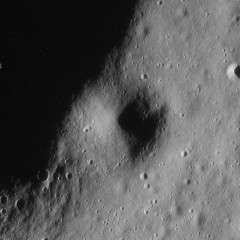Elbow (lunar crater)
 Apollo 15 panoramic camera image | |
| Coordinates | 26°02′N 3°36′E / 26.03°N 3.60°ECoordinates: 26°02′N 3°36′E / 26.03°N 3.60°E |
|---|---|
| Diameter | 340 m[1] |
| Eponym | Astronaut-named feature |
Elbow is a feature on Earth's Moon, a crater in the Hadley–Apennine region. Astronauts David Scott and James Irwin visited the east rim of it in 1971, on the Apollo 15 mission, during EVA 1. The east rim of Elbow was designated Geology Station 1 of the mission. Geology Station 2 was to the southwest of the crater, up the slope of Mons Hadley Delta.


Elbow is located on the edge of Hadley Rille, about 1 km northeast of the larger St. George crater, and about 3.2 km southwest of the Apollo 15 landing site itself.
The Apollo 15 Preliminary Science Report[2] describes Elbow as follows:
Station 1 is located on the east flank of Elbow Crater, a 400-m-diameter crater that lies near the junction of the mare surface and the Apennine Front. Elbow Crater is a relatively old Copernican-age crater formed by an impact at a sharp bend in Hadley Rille. Elbow is approximately 0.5 km north of the foot of the Hadley Delta slope. Younger small craters occur on the Elbow Crater ejecta blanket. The surface is generally flat but hummocky in detail. The surface material is composed of fine-grained soil with sparse to common pebble-size and larger fragments. The larger fragments are locally concentrated around the young, fresh crater on the Elbow Crater ejecta blanket.
The crater was named by the astronauts after its location at a bend, or elbow, in Hadley Rille, and the name was formally adopted by the IAU in 1973.[1]
External links
- Apollo 15 Traverses, Lunar Photomap 41B4S4(25)
References
- 1 2 Elbow, Gazetteer of Planetary Nomenclature, International Astronomical Union (IAU) Working Group for Planetary System Nomenclature (WGPSN)
- ↑ Apollo 15 Preliminary Science Report, 1972, NASA SP-289, Scientific and Technical Information Office, NATIONAL AERONAUTICS AND SPACE ADMINISTRATION, Washington, D.C.